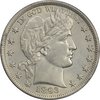Barber Half Dollars
In 1892, the Liberty Seated dollar was replaced by the Barber silver half dollars. Barber’s right-facing profile of Lady Liberty became the obverse, paired with a reverse depicting an eagle clutching an olive branch and bundle of arrows. They were only produced until 1915.
These history-rich, turn-of-the-century coins are sought after by collectors for their iconic design, the scarcity of coins that remain well-preserved, and their membership in the Barber coin series. Explore L&C Coins’ collection of Barber half dollars and expand your own today.
The Rich History of the Barber Half Dollar
Origin
In the 1880s, there was a mounting demand for a replacement for the Seated Liberty half dollar design, which was seen as bland. In 1891, Mint Director Edward Leech hosted a competition for a replacement design. Unfortunately, despite offering a cash prize, he only received a handful of entries, none of which were acceptable. Leech gave up on the competition and requested Mint Chief Engraver Charles Barber to create new designs for the half dollar, quarter, and dime. His work is what began the iconic Barber coin series.
The Barber silver half dollars would be minted at the Philadelphia and San Francisco Mints from 1892 until 1915. Additional coins were minted in New Orleans until 1909 and in Denver beginning in 1906.
Design
The obverse of the Barber half dollar depicts Liberty facing right and wearing a Phrygian cap encircled by a wreath. She is surrounded by 13 six-pointed stars around the edges of the coin. On the reverse, it features a variant of the United States seal with 13 five-pointed stars above the eagle. The eagle has a shield in front of its body and holds an olive branch in one claw and a bundle of arrows in the other. A ribbon featuring the script “E Pluribus Unum” is clutched in its beak.
However, finalizing these details was a major challenge. While the design process began in June 1891, the first coins weren’t struck until November. This was caused by numerous disagreements between Leech, the Presidential Cabinet, and Barber about virtually every part of the Barber half dollar: the shape of the stars, the depiction of Lady Liberty, what surrounded the heraldic eagle, the accuracy of the olive branch depictions, and even more.
These five months of design work did not pay off. When the coin was revealed to the public and entered into circulation, it was received with mixed reviews. The coin was considered either uninspiring or the perfect representation of the aesthetics of the time. The lackluster response led Congress to approve another design change once the coin’s production term expired in 1916.
Circulation and Availability
The Barber half dollar lasted 25 years, the bare minimum term a coin design must be approved for production. The last of them were struck in 1915, followed by their replacement in 1916 by the Walking Liberty half dollar. The total output of these coins throughout production was around 136 million coins. Despite this relatively low amount, they were regularly used by settlers during westward expansion, who prized them for their tangible silver value.
However, because of its low mintage and everyday use in a developing part of the country, many of these half dollars were lost. The ones that have been found are overwhelmingly in Good and Fine grades — Extremely Fine and greater grades are very scarce. If you can find them, key collector’s dates include the 1892-O, 1895-S, 1913, 1914, and 1915.
Expand Your Collection With L&C Coins
Founded in 1974 by Lee Crane, L&C Coins was built upon our family’s passion for coin collecting and providing high-quality, authentic coins to new and seasoned collectors. Our wide variety of coins at a range of price points has something for everyone, and our dedicated customer support team is always standing by to assist you.
Explore our collection of brilliant coins today and discover your new favorite piece of history. With every order, you’ll enjoy 15-day return privilege, available layaway plans with no interest up to 5 months, and free shipping on all standard orders.
Frequently-Asked Questions
How many Barber half dollars were struck?
The total number of Barber silver half dollars struck in the United States was 135,898,329, with the 1899 Barber half dollar produced at the highest mintage in the series at 5,538,000.
What are Barber half dollars made out of?
These half dollars were crafted from 90 percent silver and 10 percent copper, with an average weight of 12.5 grams.
What are the rarest Barber silver half dollars?
The rarest of the Barber half dollars include the 1892-O Micro O variety, 1896-O, 1901-S, 1904-S, and 1907-S. These rare examples are scarce due to their low production and are extremely valuable in Mint State condition, with the 1892-O Micro O variety half dollar in particular selling for tens of thousands of dollars.

